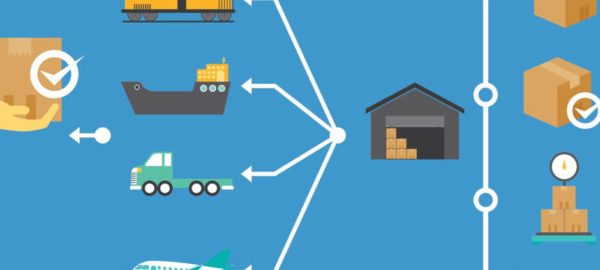September 14, 2016
Logistics describe how an organization’s supply chain works; the route through which products reach customers from the manufacturer or how a company provides its services. The logistics necessary to provide goods or services will vary between industries.
For example, a business that provides a service (such as a courier service) usually doesn’t require warehouses for long-term storage. A mass merchandiser, such as Walmart, will have a need for many warehouses of different types in many locations.
To aid in understanding how logistics may vary between industries, three examples of different logistic systems are described below:
Typical Ecommerce Logistics
Using an overnight delivery service is extremely convenient these days since the customer can initiate the order fulfillment process online.

Sellers can use a delivery service website connected to a fulfillment company to prepare a parcel for shipment to the consumer:
Software, which integrates with platforms like Shopify, WooCommerce and Magento enable sellers to automate the following:
- calculate the cost of their shipment
- pay the shipping fee online
- print their own shipping labels
These systems also offer useful information about how to pack and wrap parcels to prevent the contents from being damaged during shipment. The customer can arrange to have their parcel picked up for delivery, or take it to a local drop-off location. The staff at the drop-off location can process the package if the customer prefers not to do it online. Each parcel is assigned a tracking number and a bar code is printed on the label to identify the package so it can be tracked through the system.
To prevent damage, the parcels are loaded onto a truck with lighter packages placed on top of the heavier ones. This reduces the chance of accidental damage if the load happens to shift while the truck in moving.
When parcels are to be sent by air, they may be delivered to an airport and loaded onto a plane. Depending on how far away the final destination is, the parcels may be reloaded onto other trucks at transportation hubs to continue their journey.
At each location, as packages are transferred from one truck or plane to another, the bar codes are scanned and recorded. This allows the delivery service (and online customer) to follow each parcel as it travels through the system. If a parcel happens to get lost, the tracking number can indicate its last known location and can be used to determine that the package has arrived safely at its destination.
Typical Mass Merchandiser Logistics
A mass merchandiser, such as Walmart, imports huge quantities of merchandise and must have a well-designed supply chain network to make sure those products can reach their large number of retail stores scattered across the country.
These corporations will have various suppliers of many different types of goods, and consolidating those goods begins as the shipments are unloaded at the warehouse.

There are different types of warehouses that serve slightly different purposes, and a mass merchandiser may incorporate all or some of them in their supply chain network. Determining the optimum location for these facilities is an important factor in creating an efficient supply chain.
Cross-dock warehouses aren’t used for storage, but are merely locations where inbound trucks deliver goods that are transferred to outbound trucks, a process known in logistics as cross docking.
For example, a truck delivering 100 cases of soda may transfer those cases to several trucks, which would then transport the soda to storage warehouses or deliver them to individual retailers.
The merchandise could also be transported to a central warehouse (or hub) and consolidated, then transported to various other warehouses in the network, usually regional warehouses. Goods are stored at spoke warehouses longer than at the hub, and retail stores draw their inventory from the spokes.
A distribution center is a type of warehouse where goods are received from many locations and added to a mixed inventory, which allows customers’ orders to be shipped from one location instead of many. Retail outlets and manufacturers often have an on-site warehouse with inventory to fulfill their customers’ needs.
Typical Airline Logistics
Getting airline flights in the air on schedule takes a great deal of coordination, and the fueling process is perhaps the most important step.

Without fuel, the plane isn’t going anywhere. Airline companies usually outsource their fueling operations to fuel vendors. This relieves the airline company of many issues that are involved in fueling operations and allows them to concentrate on other tasks involved in keeping their flights on schedule.
Vendors are responsible for the upkeep of fueling trucks and other equipment, for addressing issues of safety to humans and the environment, and for training personnel required for fueling operations. Vendors also assume any liability created by fueling operations, reducing potential risk for the airline company they are servicing.
The infrastructure required for airplane fueling operations varies depending on the type of airport it is servicing:
The supply of fuel is located in a fuel tank farm which is conveniently located adjacent to the airport. Fuel is transferred from the tank farm to the airplanes by one of two methods.
Small and medium size airports are usually serviced by refueling trucks, which draw fuel from the storage tanks and deliver it to the airplane. Larger airports, or those that are especially busy, are serviced by a hydrant system, a system of underground pipes which lead to hydrant pits near the parked aircraft. A hose is attached between the hydrant and the airplane for the fueling operation.
An important step in getting a flight in the air on time is getting the passengers and baggage on the airplane before the scheduled flight time:
Airlines require passengers who have boarding passes to check in a certain amount of time before the aircraft is due to take off. Passengers who are traveling with baggage that is too large to carry on must have their baggage checked and loaded as well. The pre-flight check-in time will vary between airlines but may take 30 minutes or so before the takeoff time for domestic flights, and at least two hours for international flights. This assures that the passengers and their baggage will be ready to go so the flight can take off on schedule.
The pilots and crew members are usually required to begin their pre-flight tasks an hour or so before the scheduled flight time:
The aircraft is powered up and all systems are checked to make sure they are operating correctly. The pilot or a maintenance person will do an exterior pre-flight check for fuel leaks, bird hits or other apparent problems.
Maintenance of the airport, including the aircraft and runway, is usually outsourced. This relieves the airline company of those duties, freeing airport personnel to make sure that airport operations run smoothly and flights take off on time.
The pilot must also read his flight plan and enter data into the flight management system into the onboard computer, which links to the autopilot. During this time, the baggage is being loaded by baggage handlers, and flight attendants are helping passengers get settled for the flight and giving emergency instructions.
Once the passengers and baggage are loaded, the total weight of passengers, baggage and fuel is calculated and balanced if necessary so the weight is evenly distributed throughout the aircraft. The aircraft’s trim is set based on the aircraft balance and the pilot awaits clearance from ATC to taxi down the runway for an on-time takeoff.
Conclusion
These examples illustrate the differences between logistics systems in three different industries. Although they require different types of operations, it demonstrates how important a coordinated network of action and communication is to the successful operation of any business.
In today’s global marketplace, supply chain networks and their management become more and more complex and may need to be updated frequently to remain cost-effective and efficient.
Choosing the right locations, transportation methods, and storage options are vital components of an optimum supply chain network.
Ready to Automate Your Online Logistics for Shopify?
Business & Finance Articles on Business 2 Community
(115)








